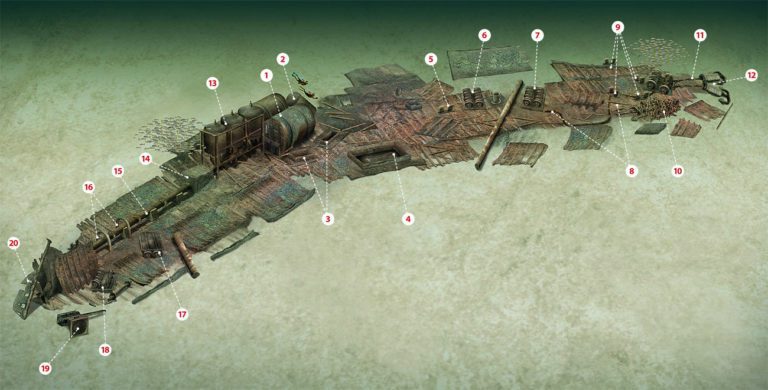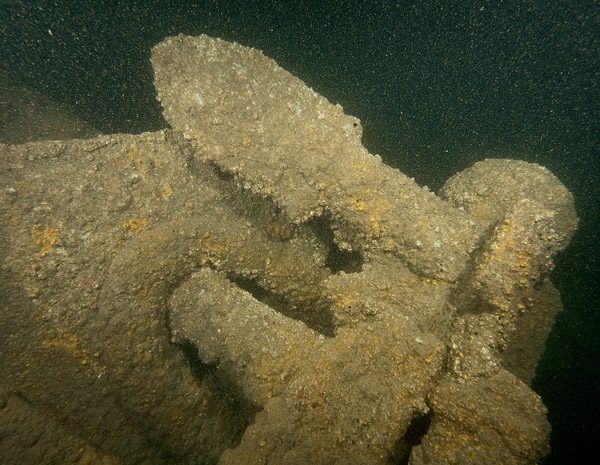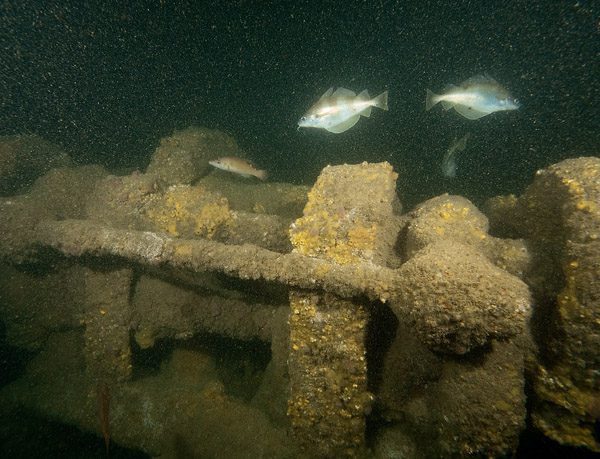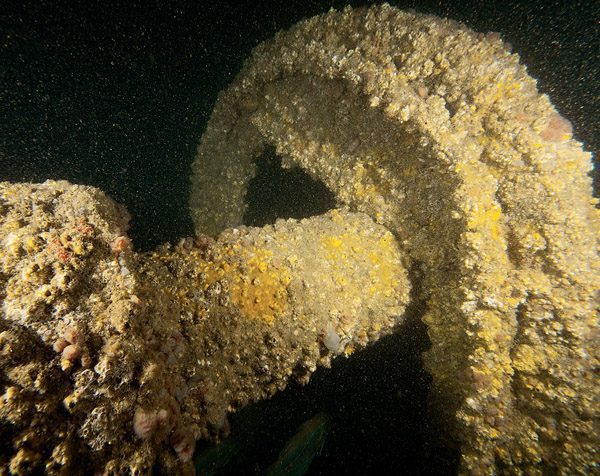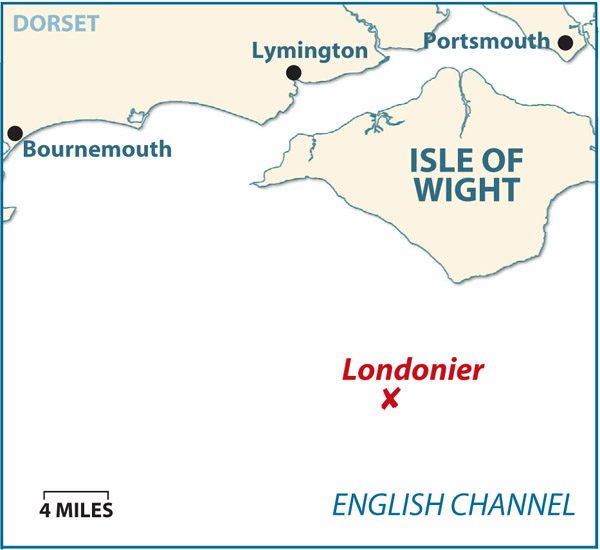This steamship was sunk south of the Isle of Wight by a U-boat towards the end of WW1. Though little dived, its engine and gun alone make it worth a visit, says JOHN LIDDIARD. Illustration by MAX ELLIS
AS IS SO OFTEN THE CASE, our tour of the 1870-ton Belgian steamship Londonier begins at the boilers (1).
This time, however, the starting-point bears more significance than usual, because this is where the line of the wreck is broken, with the bow part twisted about 20° to starboard relative to the stern.
The Londonier was torpedoed amidships and sank rapidly, so it is likely that the explosion broke the ship’s back.
The direction forward is easy to tell. The big triple-expansion engine stands high aft of the boilers, while forward of that the donkey boiler (2) rests tipped up against the boilers, slightly to port of the centre-line.
The top of the donkey boiler is nicely domed, which could suggest that it was originally upright. However, it also has a scalloped section halfway along one side, which suggests that it could have been saddled above and across the front of the two main boilers. With the lower end now buried in debris, it’s hard to come to a conclusion on this.
Most of the dive from here on is at a level 39m or 40m, depending on the size of the tide. Wight Spirit’s skipper Dave Wendes prefers to dive wrecks in the area off St Catherine’s Point on a high-water slack, so as to run with the tide most of the way to the wreck, then home with the tide after slack water.
As well as being twisted to starboard, the general collapse of the immediately forward area of the wreck was also mostly to starboard. Two hatch-coamings (3) from the Londonier’s bunkers are located just to the starboard side of the boilers.
Also offset to starboard is the hatch-coaming (4) from the number 2 hold, the first hold forward from amidships. The Londonier was in ballast, so there is no cargo to look for.
Continuing forward, we see a change in the pattern of the collapse, with a pair of bollards (5) from the port side of the deck almost on the centre-line of the keel.
Between the holds, the cargo-winches (6) and (7) have fallen in line with the keel, but perhaps displaced slightly forward from where they would have been on the undamaged ship. From between these winches, the forward mast stretches to starboard.
From the forward of these two cargo-winches (7), a steam-pipe (8) leads out and round the area of the number 1 hold, then beneath two pairs of bollards (9) to the anchor-winch (10).
The bow appears to have fallen in from an upright orientation, or perhaps it has collapsed slightly to port, because the four sets of bollards from the bow are also displaced slightly to port, and a pile of chain (11) from the chain-locker is located just to starboard of the anchor-winch.
Chain also leads forward from the anchor-winch, through a pair of hawse-pipes to the anchors (12). The surrounding seabed is hard chalk and shingle, so although the visibility off St Catherine’s Point is never brilliant, the wreck is swept clean of silt, and the visibility is never too bad.
Retracing our route aft, behind the boilers the Londonier’s triple-expansion engine (13) stands 5-6m from the seabed. The crankshaft leads into an intact thrust-bearing (14).
The propeller-shaft (15) then leads aft, supported by its bearing blocks, arched with the remains of the propeller-shaft tunnel (16).
About level with the first arch over the propshaft, and offset to starboard, is a cargo-winch (17) that has fallen upside-down. Next to it, the stub of the aft mast has fallen out to starboard. Its upper part would have been made of wood.
The Hampshire & Wight Trust for Maritime Archaeology (HWTMA) has an ongoing project to survey the Londonier, and reports that lifejackets can be found trapped under frames to the port side of the propshaft. However, these could well have been washed in and trapped at a later date, because it is unlikely that cork and canvas lifejackets from almost 100 years ago would have survived.
Continuing aft, the propshaft soon disappears below debris from the stern. Another cargo-winch, this time upright, has fallen just to starboard (18), with a detached winch-spindle further out.
Round to the starboard side of the stern, the Londonier’s gun (19) is a fine example of the 12-pounder so often fitted to the stern of WW1 merchant ships.

The term “12-pounder” refers to the weight of the shell fired, with the actual calibre of the gun being 3in. Different sizes of gun firing the same weight of shell were differentiated by appending the weight of the barrel and breech.
The Londonier carried the 12-pounder / 12cwt (hundredweight) model, one of the lighter naval varieties of this gun. Shell-cases are scattered on the seabed near it.
At the stern, the propeller remains attached to the tail of the propeller-shaft. Behind this, the rudder (20) has been displaced from the rudder-post to rest tilted against the stern.
The top of the rudder-post would make a good point from which to release a delayed SMB and ascend.
WHY NO ZIG-ZAGGING?
THE LONDONIER, freighter. BUILT 1911, SUNK 1918
BUILT IN 1911 BY IRVINE Shipbuilding & Dry Dock Co of West Hartlepool for Scheepvaart Maatschappij Gylsen as the Vrijhandel, the ship was renamed Londonier when ownership was transferred to Lloyd Royal Belge of Antwerp.
In March 1918, the Londonier was contracted by the French government to sail from Calais to Barry for orders, which would presumably have been to load cargo destined for France and the front.
In the early morning darkness of 13 March, the Londonier was off St Catherine’s Point in the company of another steamship and two Admiralty trawlers, steaming for the Needles at 9.5 knots.
For some reason the ships were not zig-zagging, which was a surprising and fatal mistake, as U-boats were known to be operating in the area.
A U-boat was spotted on the surface about 200m away and the Londonier altered course, but it was too late, and a pair of torpedoes struck amidships.
Captain Sven Degryse ordered the crew to abandon ship as the Londonier rapidly sank, but she took 12 men from the crew of 25 with her.
The U-boat responsible was UC71 from the Flanders Flotilla, commanded by Oberleutnant Walter Warzecha.
Previously on that patrol Warzecha had torpedoed and damaged the 4257-ton Saba off Royal Sovereign Shoal on 8 March, then damaged the 5754-ton Clarissa Radcliffe and the 4264-ton Savan, both off Anvil Point on 12 March.
Earlier that same night, UB59 had torpedoed the 1025-ton steamship Tweed, also off St Catherine’s Point. Londonier’s crew may even have seen or heard the explosion.
The Admiralty investigation reported that the Londonier may have been silhouetted against the white cliffs of St Catherine’s Point, but no mention was made of why the ship had failed
to zig-zag.
UC71 survived the war, only to sink in the North Sea while on passage to surrender on 20 February, 1919.
TOUR GUIDE
GETTING THERE: From the roundabout at the M27 junction 1, turn south on the A337 through Lyndhurst and continue on to Lymington. Head towards the town centre until the road takes a sharp right turn uphill to the high street. Rather than go up the high street, continue straight on and follow the road downhill to the river and marinas.
HOW TO FIND IT: The GPS co-ordinates are 50 28.59N, 001 23.07W (degrees, minutes and decimals). The wreck lies with its bow to the south-east.
TIDES: Slack water is essential, and occurs 25 minutes after high water Dover. On spring tides slack is very short, and can be a few minutes later than this.
DIVING: Wight Spirit, skipper Dave Wendes, 02380 270390.
AIR: TAL Scuba, Christchurch, 01202 473030. Forward Diving, Poole, 01202 677128.
ACCOMMODATION: The New Forest is a popular tourist area, with all levels of accommodation from camping to hotels readily available. Call 01590 689000.
LAUNCHING The slip in the marina at Lymington is tidal and dries towards low water.
QUALIFICATIONS: The 39m depth of the Londonier means that divers should have a Deep, Advanced Nitrox or Dive Leader qualification.
FURTHER INFORMATION: Admiralty Chart 2045, Outer Approaches to the Solent. Admiralty Chart 2615, Bill of Portland to the Needles. Ordnance Survey Map 196, The Solent & the Isle of Wight. South Coast Shipwrecks of East Dorset & Wight by Dave Wendes. World War One Channel Wrecks, by Neil Maw.
PROS: A little dived wreck with a magnificent engine and gun.
CONS: Short slack water, and an area not renowned for its underwater visibility.
DEPTH: 35-45m
Thanks to Dave Wendes, Derek Bridle, Jay, Dave Robbins, HWTMA.
Appeared in DIVER January 2012
